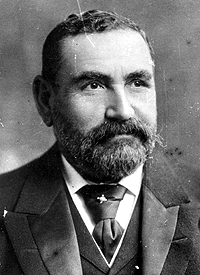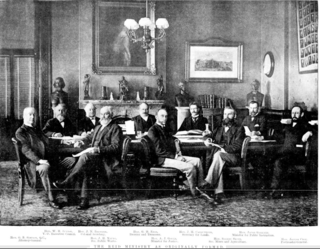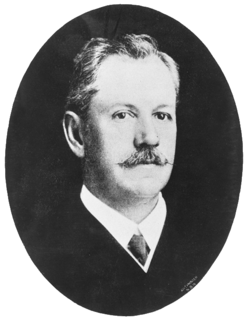Related Research Articles

Sir John See was a member of the New South Wales Legislature from 26 November 1880 to 15 June 1901, and was then Premier of New South Wales from 1901 to 1904.

Bourke was an electoral district of the Legislative Assembly in the Australian state of New South Wales from 1880 to 1904, including the towns of Bourke and Cobar. It elected two members simultaneously between 1882 and 1889 increasing to three members until 1894, with each elector being able to vote for as many candidates as there were vacancies.

The Reid ministry was the 28th ministry of the Colony of New South Wales, and was led by the 12th Premier, George Reid. The title of Premier was widely used to refer to the Leader of Government, but was not a formal position in the government until 1920. Instead the Premier was appointed to another portfolio, usually Colonial Secretary but on this occasion Reid took the portfolio of Colonial Treasurer until July 1899 and then Attorney General.

The See ministry was the 30th ministry of the New South Wales Government, and was led by the 14th Premier, Sir John See. The title of Premier was widely used to refer to the Leader of Government, but was not a formal position in the government until 1920. Instead the Premier was appointed to another portfolio, usually Colonial Secretary.

The Waddell ministry was the 31st ministry of the New South Wales Government, and was led by the 15th Premier, Thomas Waddell. The title of Premier was widely used to refer to the Leader of Government, but was not a formal position in the government until 1920. Instead the Premier was appointed to another portfolio, usually Colonial Secretary, however in this case Waddell chose to retain his previous portfolio of Colonial Treasurer.

The Carruthers ministry was the 32nd ministry of the New South Wales Government, and was led by the 16th Premier, Joseph Carruthers. The title of Premier was widely used to refer to the Leader of Government, but was not a formal position in the government until 1920. Instead the Premier was appointed to another portfolio, usually Colonial Secretary. In this case, Carruthers chose the portfolio of Treasurer.
Clarence, an electoral district of the Legislative Assembly in the Australian state of New South Wales, has had two incarnations, the first from 1859 to 1920, the second from 1927 to the present.

The 1922 New South Wales state election was held on 25 March 1922. This election was for all of the 90 seats in the 26th New South Wales Legislative Assembly and it was conducted in multiple member constituencies using the Hare Clark single transferable vote. The 25th parliament of New South Wales was dissolved on 17 February 1922 by the Governor, Sir Walter Edward Davidson, on the advice of the Premier James Dooley.

The 1907 New South Wales state election was held on 10 September 1907 for all of the 90 seats in the 21st New South Wales Legislative Assembly and it was conducted in single-member constituencies with a first past the post voting system. Both adult males and females were entitled to vote, but not Indigenous people. The 20th parliament of New South Wales was dissolved on 19 August 1907 by the Governor, Sir Harry Rawson, on the advice of the Premier, Sir Joseph Carruthers.

The 1904 New South Wales state election was held on 6 August 1904 for all of the 90 seats in the 20th New South Wales Legislative Assembly and it was conducted in single-member constituencies with a first past the post voting system. For the first time, women were entitled to vote. Both adult males and females were entitled to vote, but not Indigenous people. The 19th parliament of New South Wales was dissolved on 16 July 1904 by the Governor, Sir Harry Rawson, on the advice of the Premier, Thomas Waddell.
The 1904 New South Wales state election was held on 6 August 1904. It involved 90 electoral districts returning one member each, a reduction from 125 to 90. Women were given the right to vote for the first time in New South Wales elections, almost doubling the number of enrolled voters. As a result, it is not possible to tell the notional holder of a seat prior to the election.
The Darling, an electoral district of the Legislative Assembly in the Australian state of New South Wales was created in 1904 and abolished in 1913.
The 1907 New South Wales state election involved 90 electoral districts returning one member each. The election was conducted on the basis of a simple majority or first-past-the-post voting system.
The 1904 New South Wales state election involved 90 electoral districts returning one member each. The election was conducted on the basis of a simple majority or first-past-the-post voting system. There were two significant changes from the 1901 election, the first was that women were given the right to vote, which saw an increase in the number of enrolled voters from 345,500 in 1901, to 689,490 in 1904. The second was that as a result of the 1903 New South Wales referendum, the number of members of the Legislative Assembly was reduced from 125 to 90. The combined effect of the changes meant that the average number of enrolled voters per electorate went from 2,764, to 7,661, an increase of 277%. Leichhardt was the only district that was not substantially changed, while The Macquarie and The Murray districts retained nothing but the name.
Grafton, an electoral district of the Legislative Assembly in the Australian state of New South Wales was created in 1880 and abolished in 1904.
Blayney, an electoral district of the Legislative Assembly in the Australian state of New South Wales was created in 1904 and abolished in 1913.
Deniliquin, an electoral district of the Legislative Assembly in the Australian state of New South Wales was created in 1894 and abolished in 1913.
The Richmond, an electoral district of the Legislative Assembly in the Australian state of New South Wales, was created in 1880 and abolished in 1913.
St Leonards, an electoral district of the Legislative Assembly in the Australian state of New South Wales was created in 1894 and abolished in 1904.
Surry Hills, an electoral district of the Legislative Assembly in the Australian state of New South Wales had two incarnations, from 1904 until 1920 and from 1927 until 1930.
References
- ↑ Green, Antony. "The district of Grafton". New South Wales Election Results 1856-2007. Parliament of New South Wales . Retrieved 6 December 2019.
- ↑ Henry, Keith. "See, Sir John (1845–1907)". Australian Dictionary of Biography . Vol. 11. Melbourne University Press. ISSN 1833-7538 . Retrieved 5 December 2019– via National Centre of Biography, Australian National University.
- ↑ "Government Gazette Notices". Government Gazette of the State of New South Wales . No. 340. 21 June 1904. p. 4935. Retrieved 6 December 2019– via Trove.
- ↑ "Sir John See (1845–1907)". Former Members of the Parliament of New South Wales . Retrieved 11 May 2019.
- ↑ Green, Antony. "1901 Grafton". New South Wales Election Results 1856-2007. Parliament of New South Wales . Retrieved 17 March 2020.
